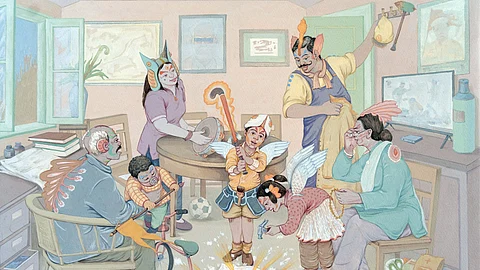
- HOMEGROWN WORLD
- #HGCREATORS
- #HGEXPLORE
- #HGVOICES
- #HGSHOP
- CAREERS
- ABOUT US
- CONTACT US

The 15th century was a time of great upheaval in the Indian subcontinent. On one hand, the Islamic conquest of India had resulted in a reversal of power dynamics and social norms, customs, and traditions within Indian society; and on the other hand, increasing oppression, marginalisation, and exploitation of the peasant classes by the Brahmanical Hindu elite led to a crisis of faith among the masses.
Set against this socio-political context, the Bhakti movement was a religious reformation movement that sought to make Hinduism more equitable and accessible to its adherents by promoting 'bhakti' or devotion as the ideal path to salvation. Bhakti preachers, spiritual leaders, and poets like the Alvars and the Naynars of South India, Sant Kabir, Chandidas, and Sri Chaitanya used ordinary everyday language to preach so their message could reach the masses.
However, the Bhakti leaders were no gentle mystics. They were among the greatest iconoclasts of their era. They attacked the rigid social and religious orthodoxies of the time and opposed those who upheld and enforced such exclusive norms and customs. Using riddles, anecdotes, satire, and absurd poetry in a little-known constructed language known as 'ulatbansi', or the 'upside down language', Bhakti poets like Sant Kabir questioned the conventional structures of devotion, religiosity, pilgrims, and pilgrimages.
Rooted in the spirit of this centuries-old tradition of using mystic-absurdist motifs and idioms to question the status quo, Baroda-based contemporary artist Yogesh Ramkrishna's debut solo exhibition 'Ulatbansi' at Latitude 28, New Delhi, presents a compelling critique of our contemporary realities. Ramkrishna’s works — interweaving mythological, historical, and modern motifs and metaphors — blend satire, drama, and dark humor to explore the paradoxical nature of social constructs and the impact of simulated realities on individual and collective identities.
Using the absurdist ideas of the ulatbansi tradition and drawing from French sociologist and philosopher Jean Baudrillard's concept of Hyperreality — a state of society where the distinction between reality and its simulacra is so blurred that simulations of reality, whether through media, virtual environments, or social personas, are perceived as more real than reality itself — Ramkrishna's works explore how media constructs, and virtual environments shape our understanding of truth, often presenting distorted realities that manipulate public perception. By dissecting these fabrications, Ramkrishna underscores the resulting socio-political tensions and insecurities. Through his work, he encourages viewers to look beyond the apparent and engage with the underlying questions about contemporary life and its illusions.
Curated by independent curator and art consultant Satyajit Dave, the exhibition features paintings, sculptural props, and interactive objects that merge mythology, history, and contemporary experiences to examine modern societies' systemic failures, cultural propaganda, and the friction between tradition and modernity in the post-truth era.
About the artist:
Yogesh Ramkrishna is a Baroda-based artist known for his insightful commentary on contemporary socio-political landscapes. Follow him here.
Ulatbansi by Yogesh Ramkrishna is on view from 31st January till 15th March 2025 at LATITUDE 28, New Delhi. Learn more about the exhibition here.
If you enjoyed reading this, here's more from Homegrown:
Attend An Audio-Visual Performance By Big Fat x MYLES, philtersoup, & More This Saturday
The Homegrown Festival 2025 Will Feature A Larger-Than-Life Installation By Nimish Kotwal
Experience A Confluence Of Art & Culture: A Homegrown Guide To India Art Fair 2025
